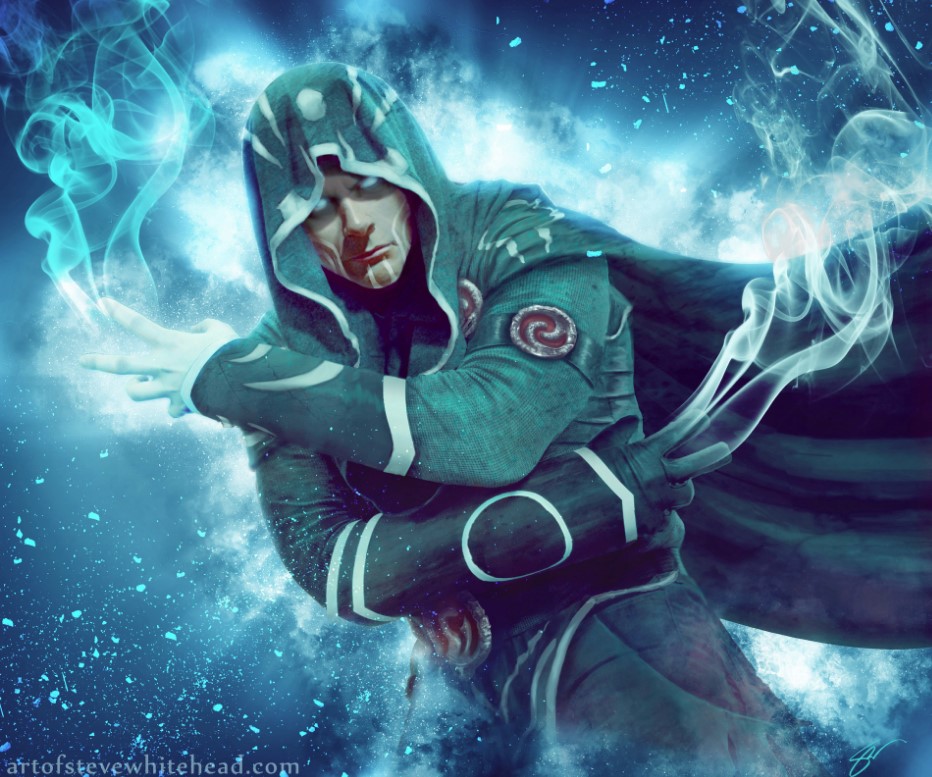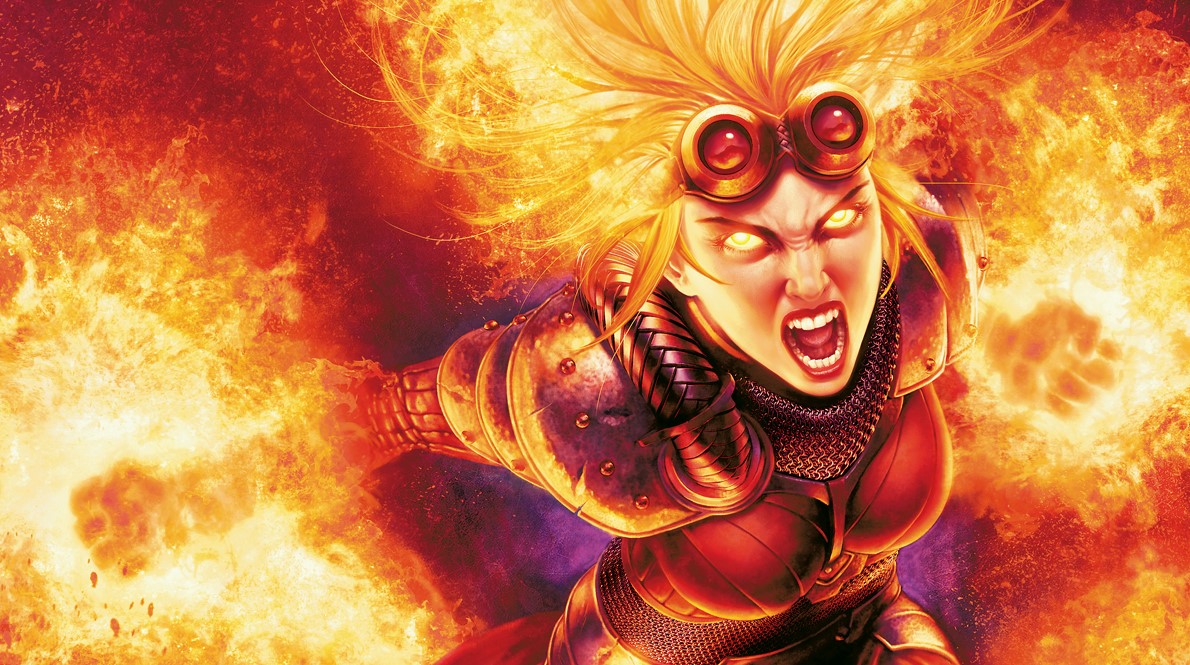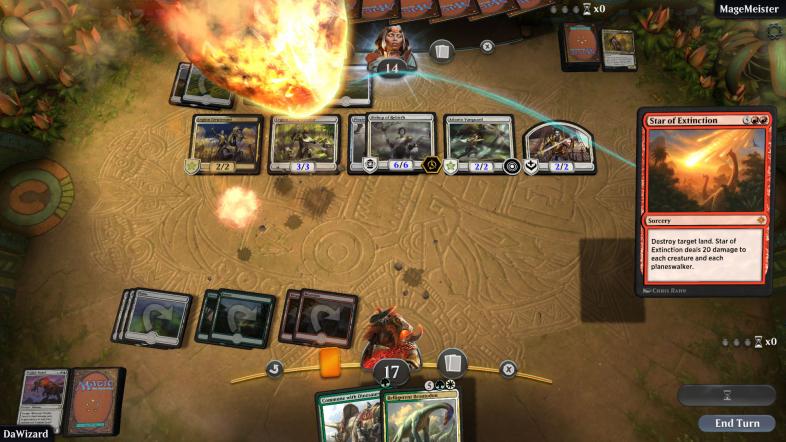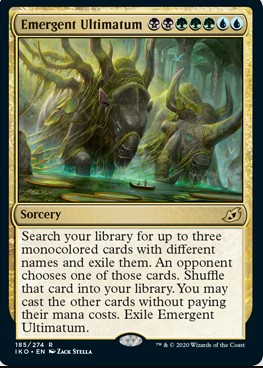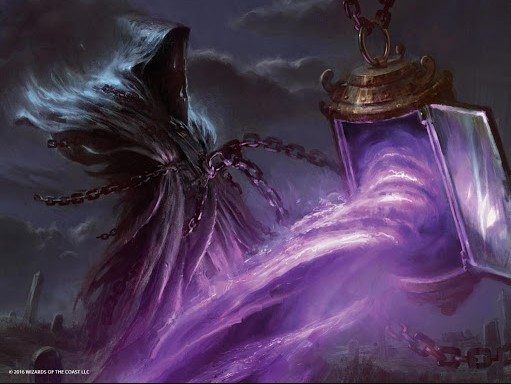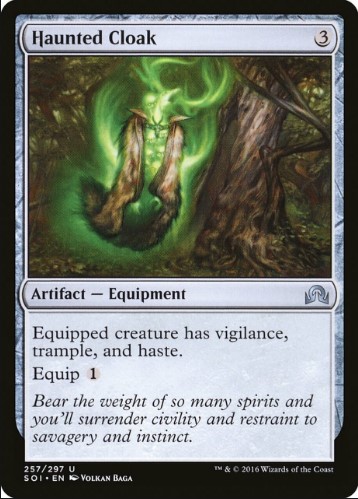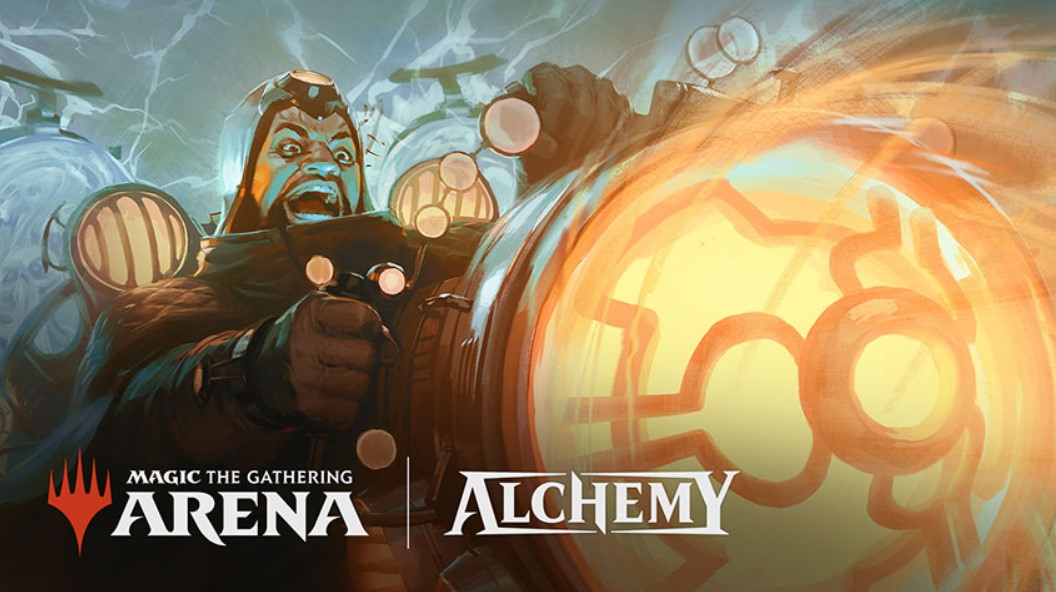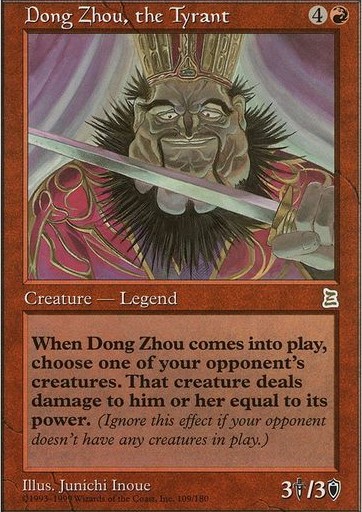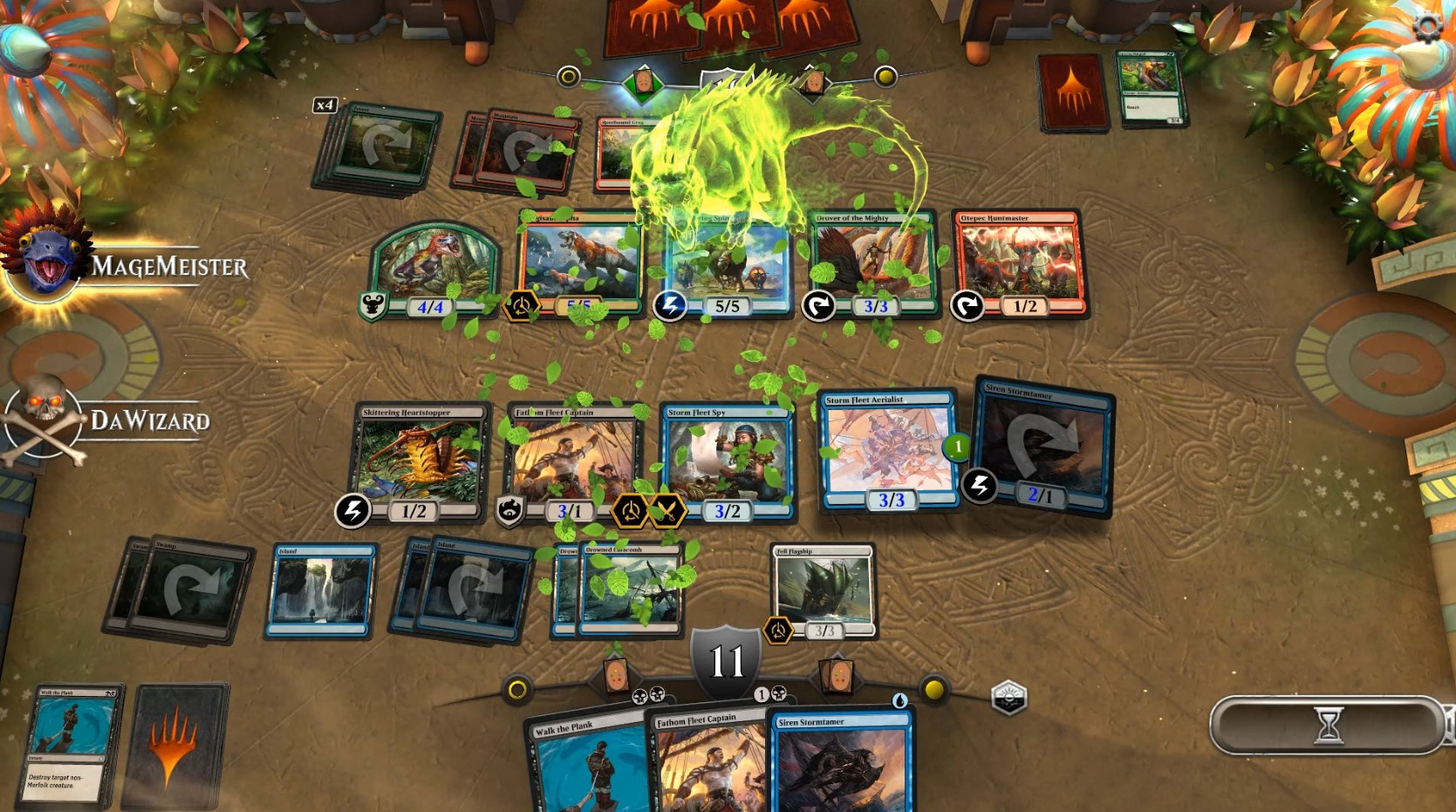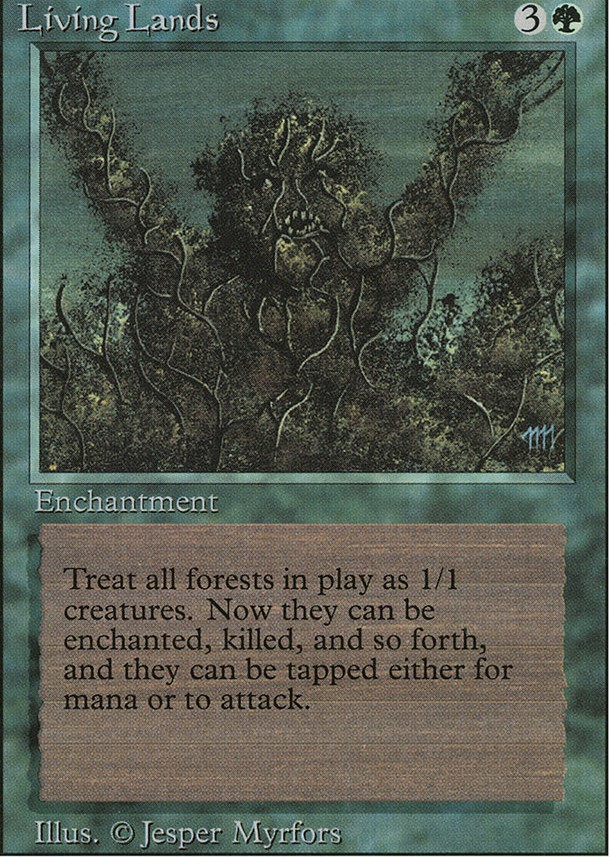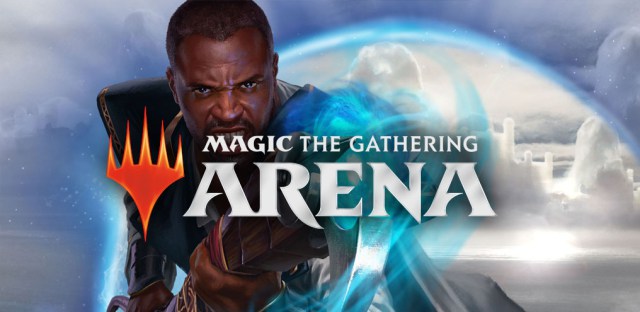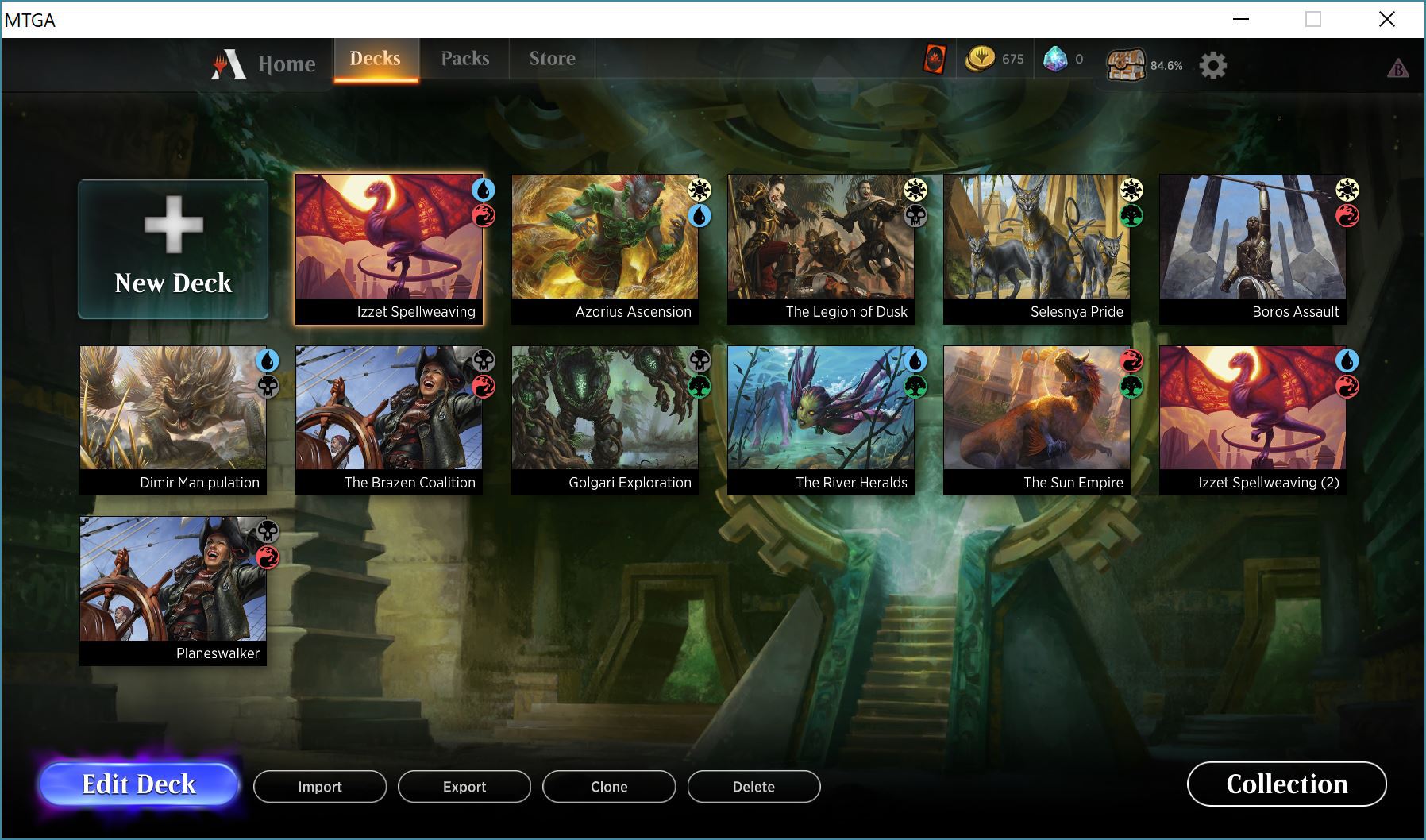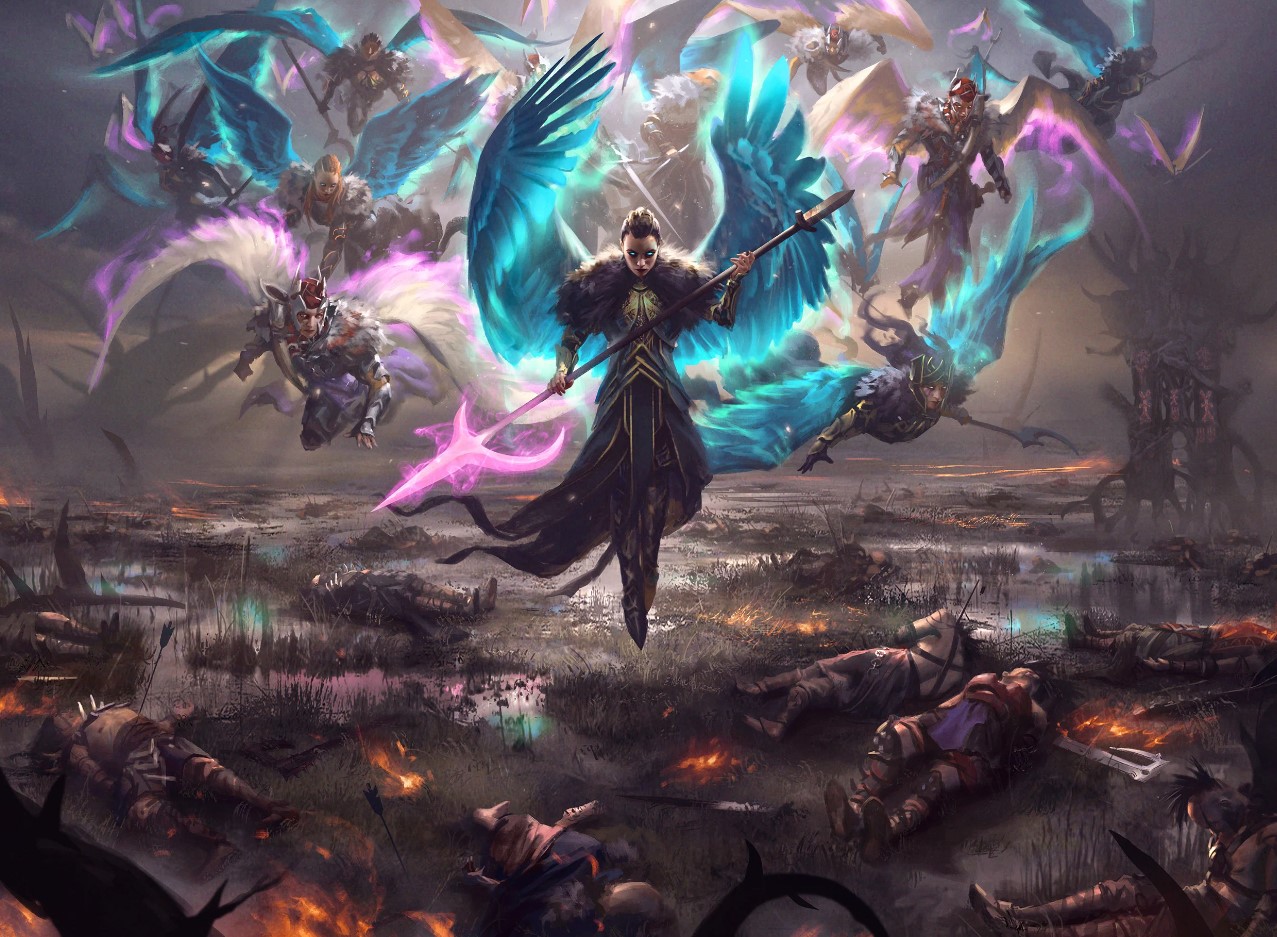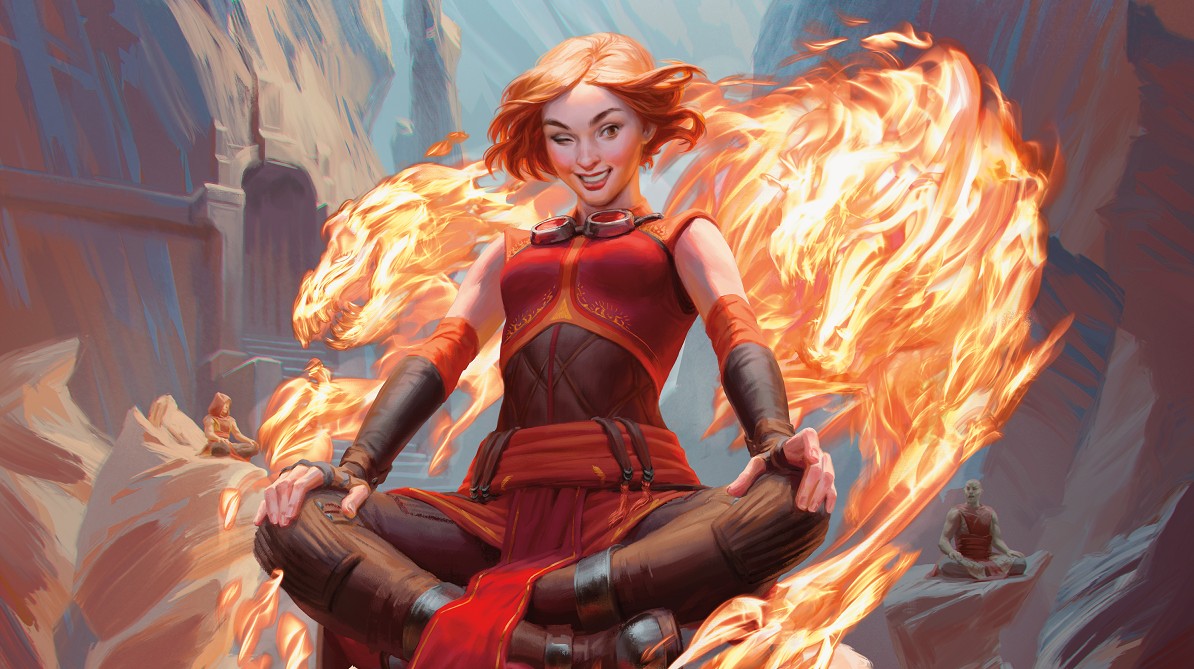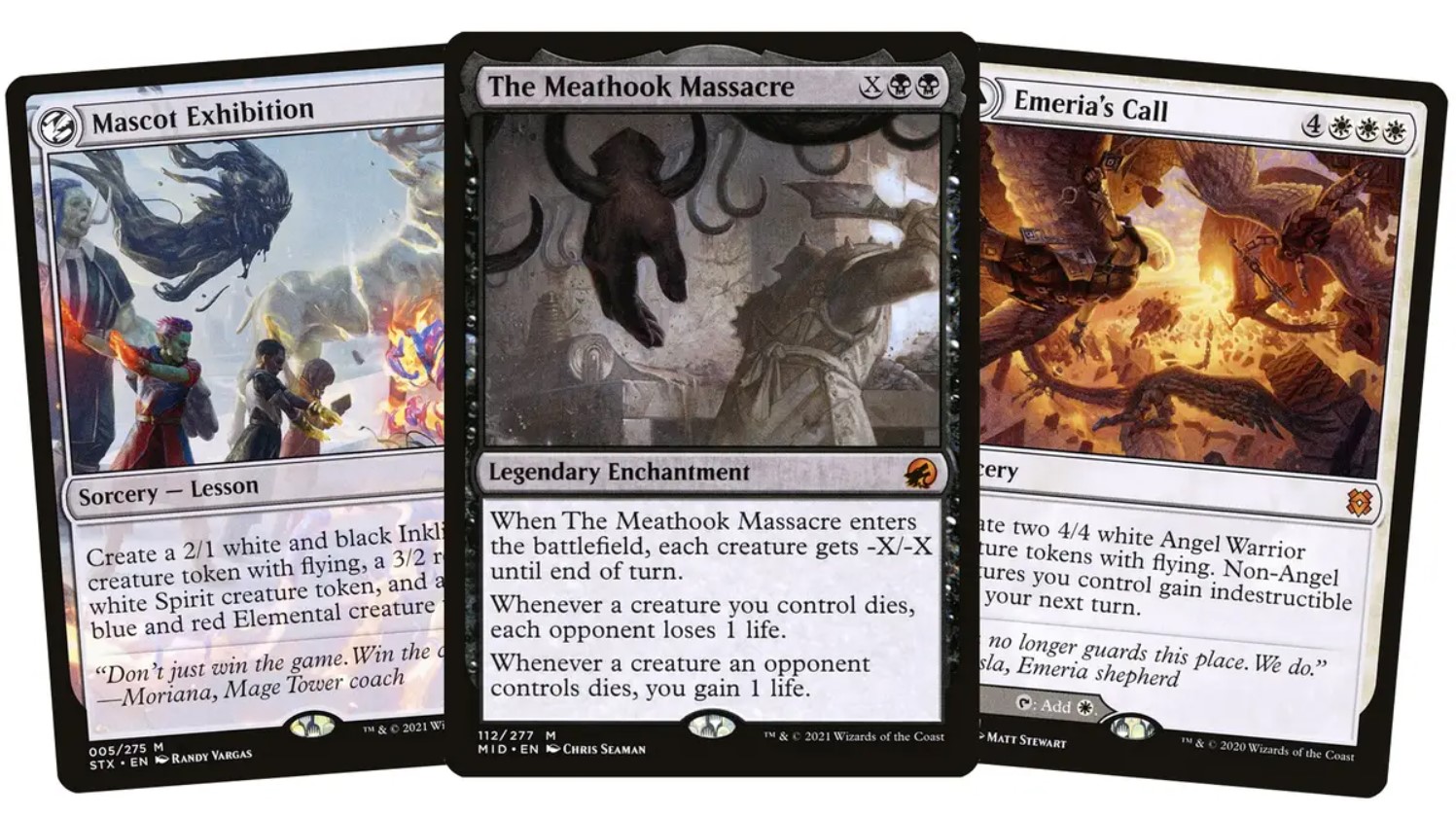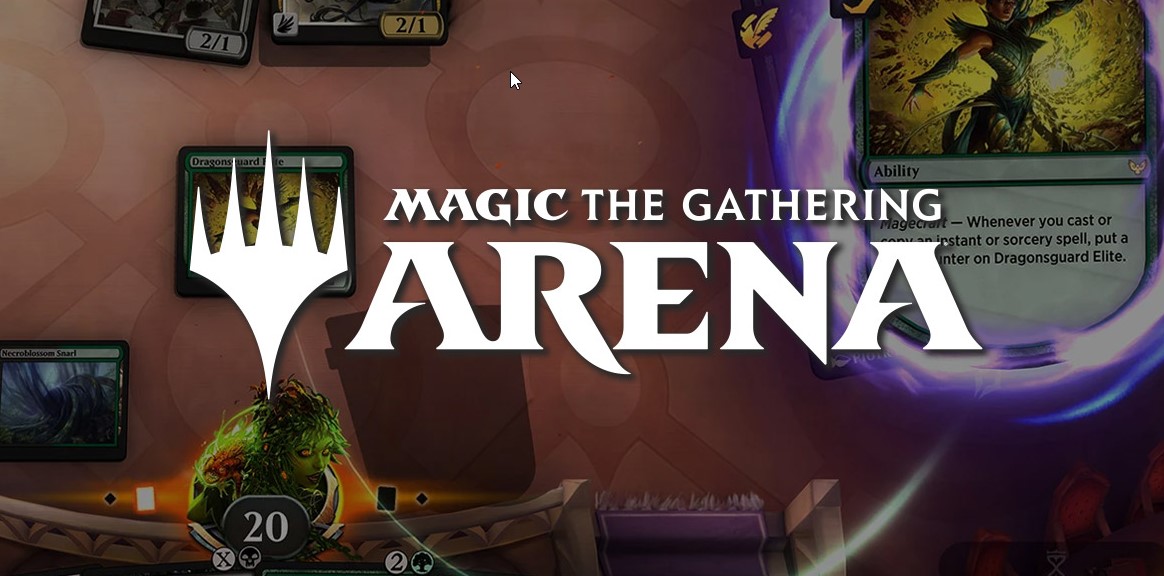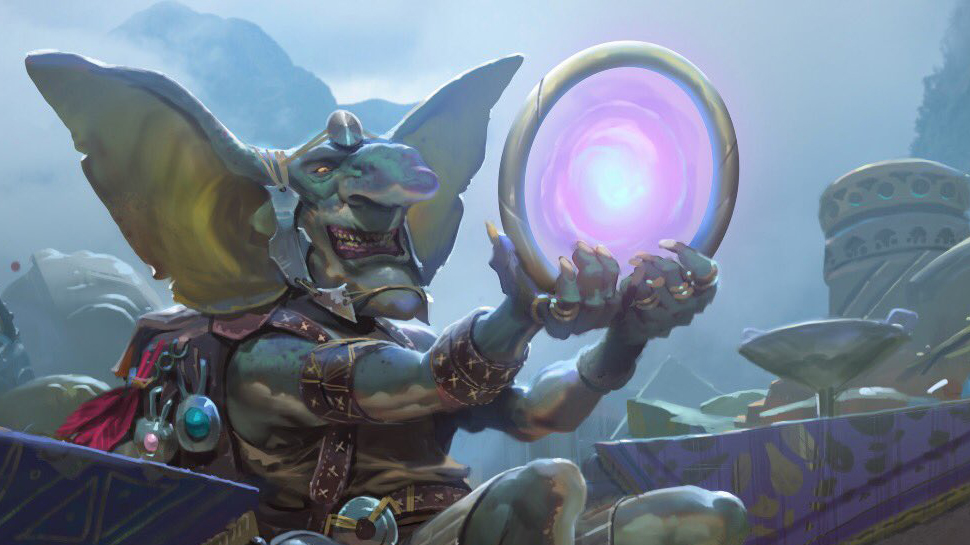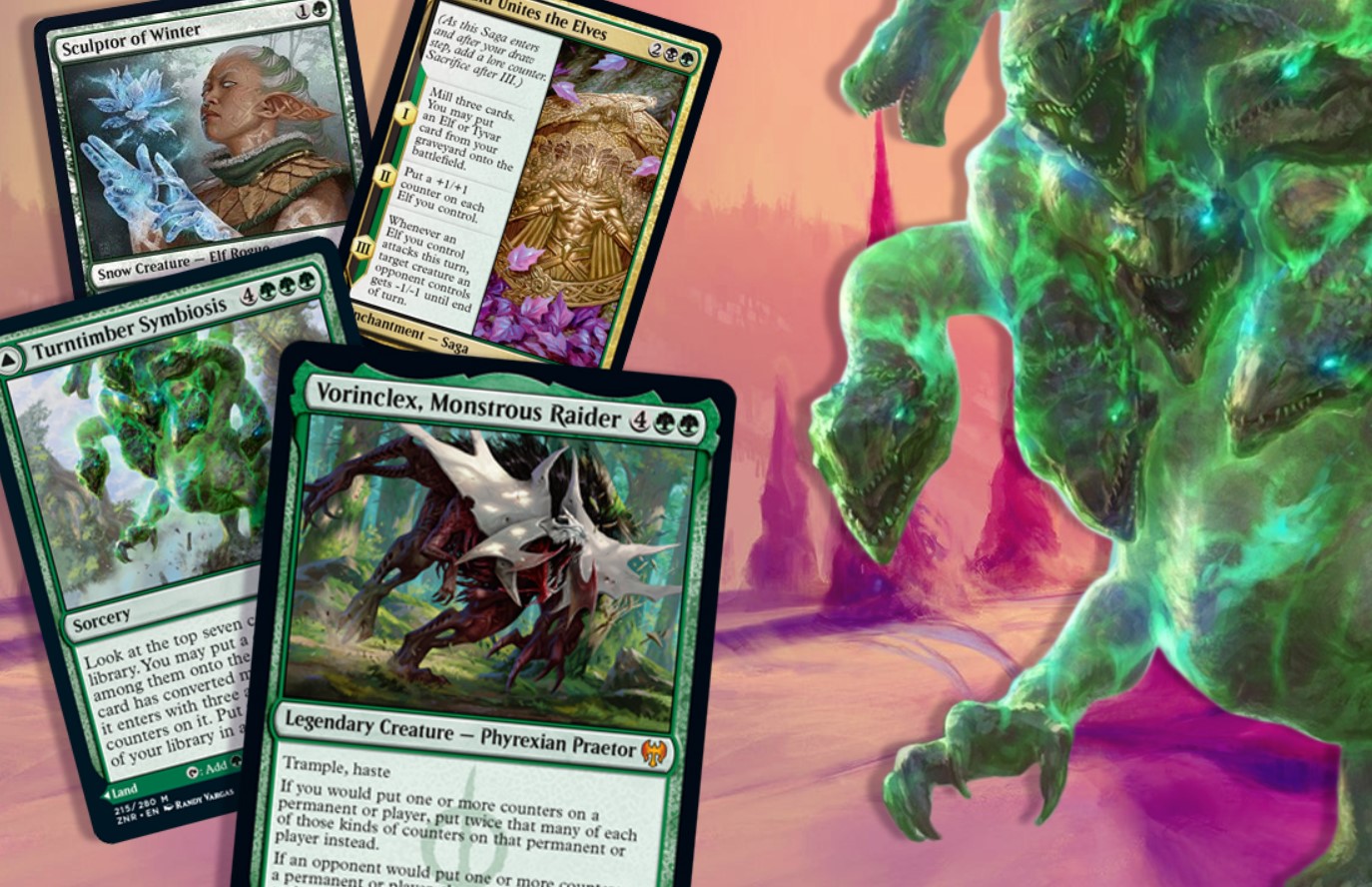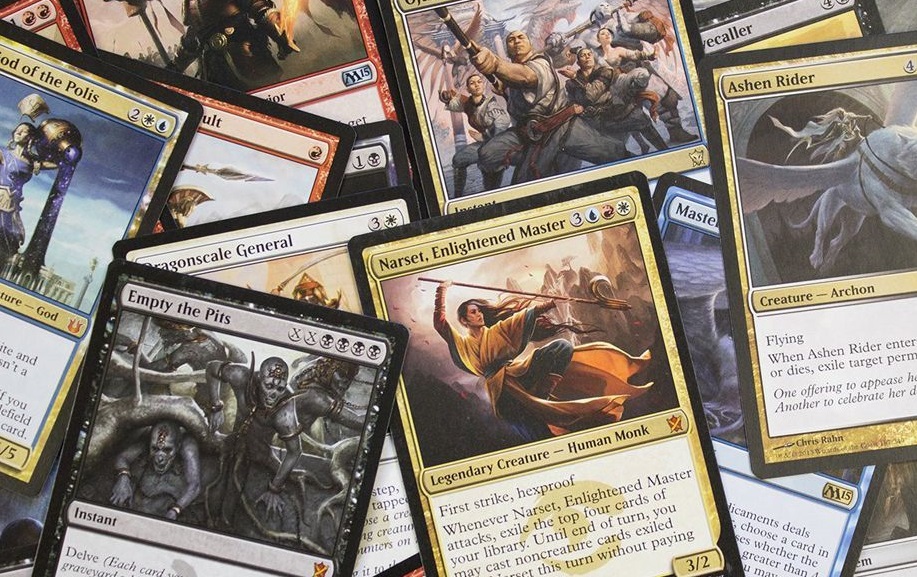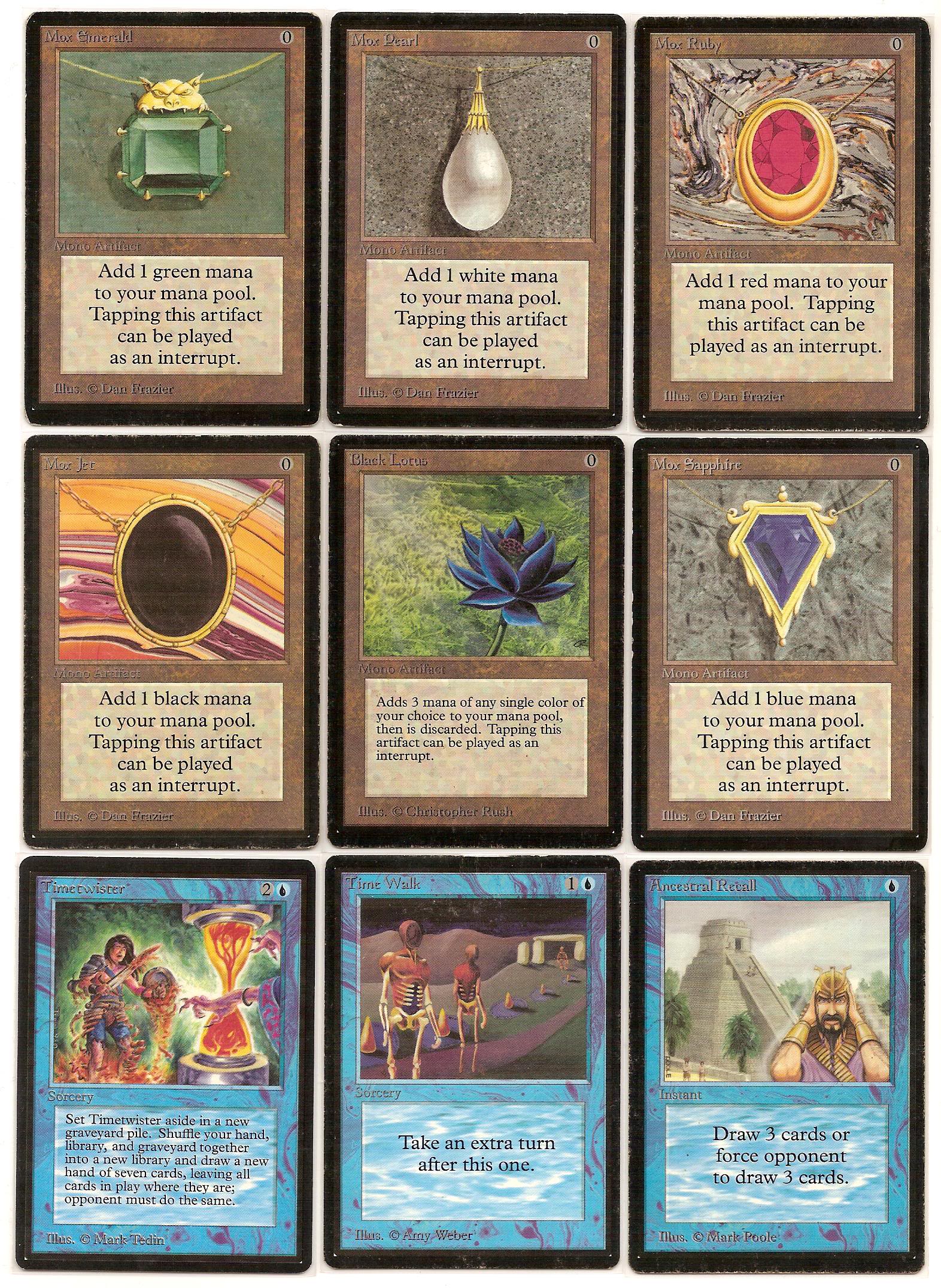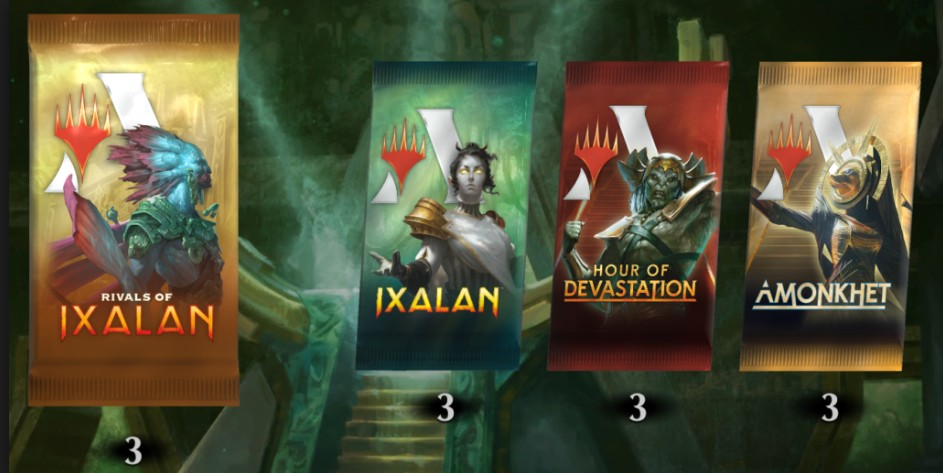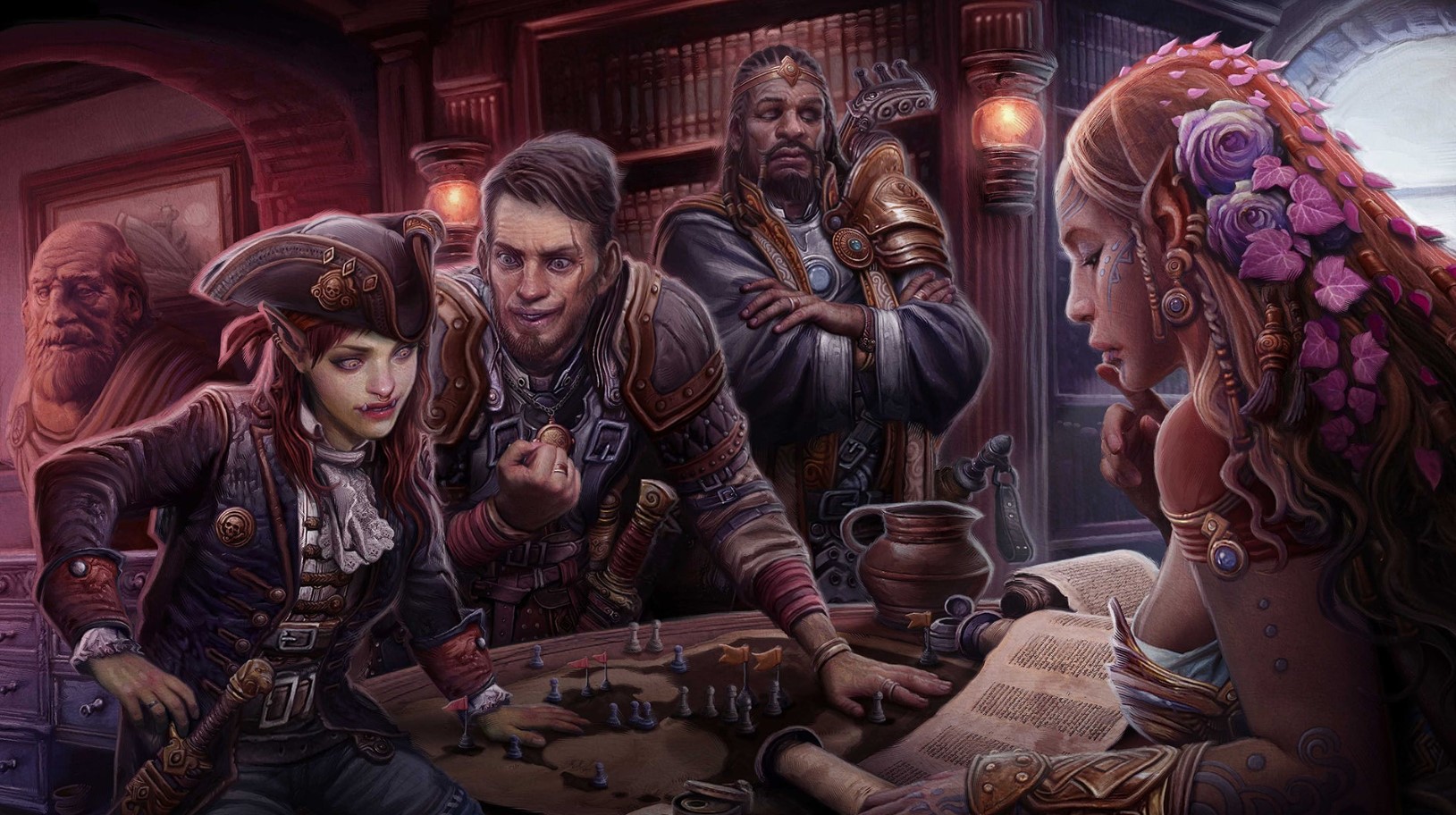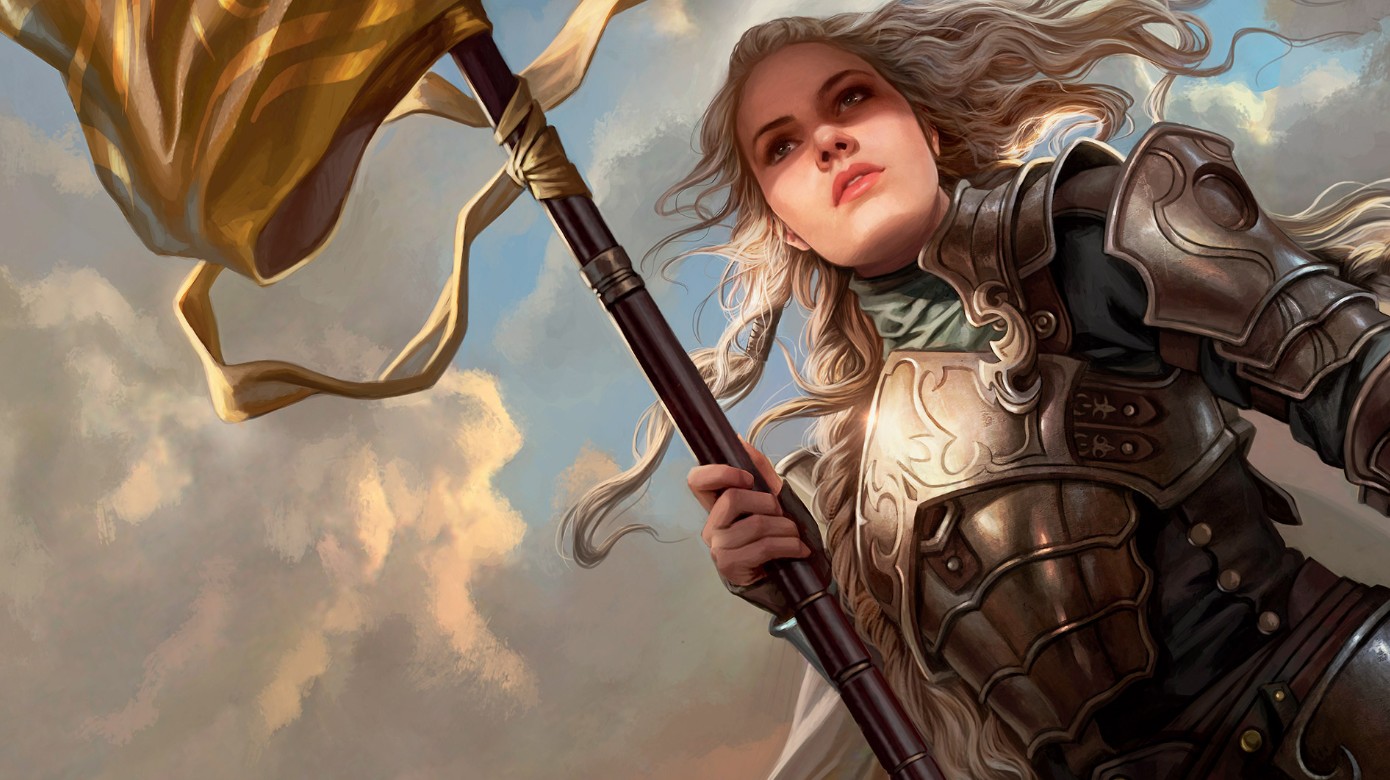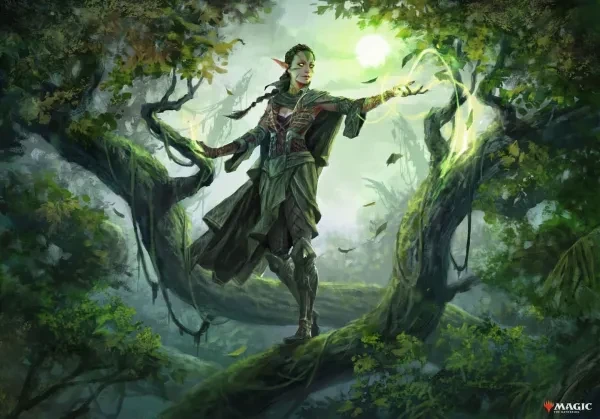
Green isn’t just my favorite color in daily life, it’s also my favorite color to play in Magic the Gathering. There’s something about the creature interactions that just spark joy in the back of my tiny monkey brain. Watching one or two drop cards quickly spread and ramp out of control and interact with other creature types makes me feel like I’m commanding my own little army.
While you may not always draw into your synergies and removal is slightly lacking without hitting them with damage, green blends wonderfully into the other colors of Magic. Add it into black and get Golgari graveyard, blue for Simic counters, or a bloodthirsty red/green Gruul deck filled with burn spells and aggressive creatures.
20. Dance of the Tumbleweeds (Sorcery)
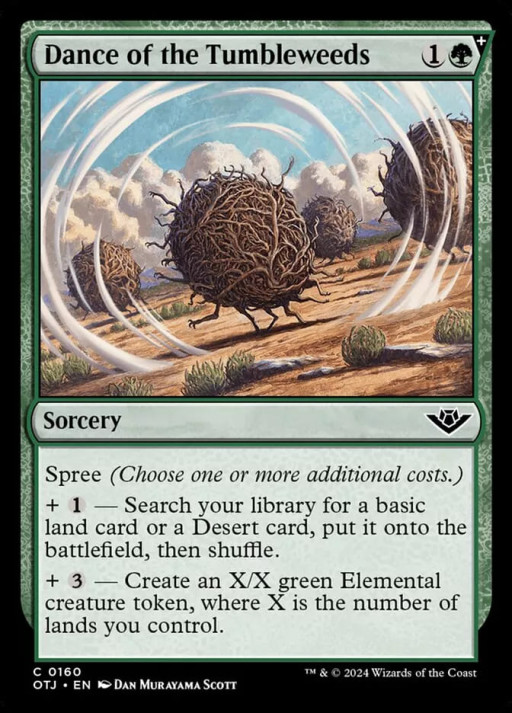
Surprisingly, this list contains quite a few commons and uncommons, green players are among the top at finding unique and interesting synergies between some of the most random cards. With Outlaws of Thunder Junction introducing the new Spree mechanic, you have a lot of options and chances for synergy. Take Dance of the Tumbleweeds here, while the cost may appear high at six mana for both casts, the rulings are where things get interesting.
You can’t interrupt the stack of the two abilities meaning, they can’t counter it as a creature, they have to counter the spell specifically. You also don’t need to tap the land to create that X/X so if you’ve done what you're supposed to do with green and ramped into a ton of mana, you should have plenty left over to cast something else. Make that something else a Vorinclex and that X/X is doubled every combat.
-
You can choose to use this card in early game just to ramp up your mana.
-
You don’t technically have to use the mana to get the X/X, just to cast Dance of the Tumbleweeds.
-
If you want to get pricey, the original, original dual lands count as two lands which would up the amount for this card.
-
Most of the time, desert cards do damage directly to your opponent or creatures and trigger the Crime mechanic.
19. Nissa Resurgent Animist (Creature)
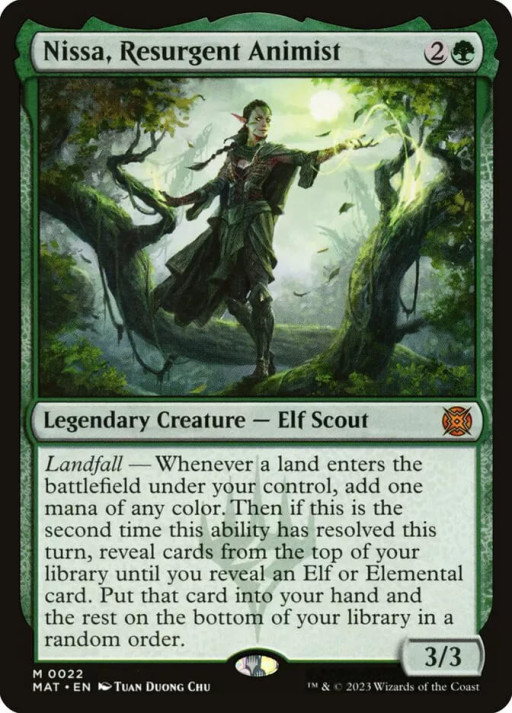
Nissa, the poster child of green throughout green’s history coming in hot with her signature ability, Landfall. This mechanic works anytime you play a land, usually pumping out some form of elemental or extra mana. In this case it’s a little of both, giving you an extra mana to spend every time you play one. If you manage to get out two in a turn (which isn’t that hard to do in green) you get to draw into an extra creature.
If you can get your hands on some older cards for commander, you can top deck a Ashaya, Soul of the Wild which will turn all your non-token creatures into forests as well. Combine that with the card above this and that elemental will get so much bigger. Being a legendary means she could be a powerhouse of a commander, speeding up your entire strategy.
-
For three mana, Nissa only needs to sit on the board to gain value.
-
Drop a land after playing her, and immediately get that trigger for another mana.
-
Strong contender for a commander deck revolving around Landfall and elves.
-
Consider all the other Landfall effects that could combo with Nissa’s and you can get a lot of value just laying down a land each turn.
18. Colossal Rattlewurm (Creature)
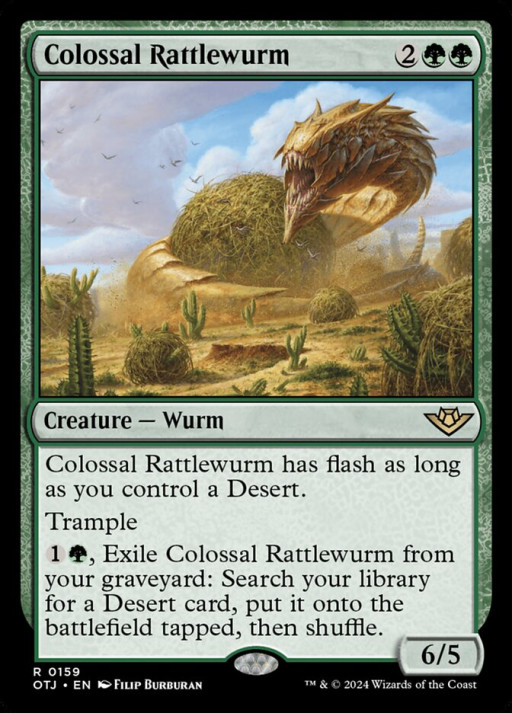
I’m a little unsure how Colossal Rattlewurm got away with all these effects At 6/5 toughness and power, only costs four mana, has trample, and can search up a desert land after dying. While the flash effect is nice, it’s completely unnecessary, though it will come in handy later in the game.
There are very few cards that cost four mana and get you higher than a 5/5. The fact this card has trample and such a high power, means that a lot of your opponents are going to be caught off guard even without flash. This guy isn’t even legendary, meaning if you have eight mana on board (again, not hard to do in green) and a desert, you can drop two of these at the end of your opponent's turn and swing out immediately.
Where the desert tutor ability really comes into play is when you remember the fact that they can trigger Crime abilities in the same set. Combine that with the fact that if he does get taken out you aren’t left with nothing and I’d say he’s pretty good value in most formats.
-
Four cost 6/5 with trample and possibly flash should be in every green/blue Simic deck.
-
He isn’t legendary so you can cheat out multiples before your turn even starts.
-
His trample effect will most likely result in taking out multiple of your opponents creatures.
-
Flash him in as a surprise blocker to take out one of your opponents pesky win conditions.
17. Virtue of Strength (Enchantment)

Introducing our first real ramp card, Virtue of Strength has an “in case of emergency” button for only one mana that helps tremendously. Let’s be honest no one is using this in standard format for its fairly heavy seven cost. What they are doing is abusing the hell out of that one cost sorcery attached to it.
I suppose I shouldn’t say no one is using this card for its intended use, it is entirely usable in constructed formats. But with the amount of blue and black discard effects, this gives you an opportunity to use it before being lost to the void. If we take a closer look, the fine print at the bottom of the spell is what really makes it special, letting you hold onto this card in your exile zone until you're ready to cast it.
Without the threat of discard, you can still play this card fairly early to get a creature back and have that removal spell be nullified essentially. This enchantment then does something special, it lets you play it from exile later on. It’s fairly easy in Magic to discount cards because they cost too much but green seeks to dispel that myth with cards like this one.
-
Can be cast early on to protect it from removal until you’re ready to play it.
-
A solid one or two of in any green deck will see value throughout the entire game.
-
The sorcery portion will let you pull lands and creatures if you’re up against a heavy mill deck or are running one yourself.
16. Omenpath Journey (Enchantment)

Omenpath Journey is a perfect example of the type of plays you’ll be making in the color green. Like a lot of mythics printed in standard today, they are geared more towards longer formats like commander. That’s not to say this card doesn’t have its uses, at four mana you’re giving yourself the ability to ramp into non-basic lands you need for the next five turns.
While the enchantment can be destroyed all is not lost, at least not according to the rules as of right now. Since exile is a zone itself those cards may be removed from play but, according to the official rules regarding the exile zone, “the exiled card may be returned to where it came from or moved to another zone, be copied, have its attributes referenced by other abilities, or be played from exile, among other options.”
This leaves some room for interpretation. If you were to lay down another Omenpath Journey after the first one had been destroyed, the second copy should still pull from that first grouping of lands as well as the new ones exiled. This is all still speculation, as Wizards of the Coast has yet to reveal a ruling on this but I suspect it will be legal.
-
Passive land ramp for any green applications.
-
Cards (should) be recoverable with another copy of the card, if the first is destroyed.
-
The card doesn’t specify basic lands, letting you pull exactly what you need.
15. Ornery Tumblewagg (Creature)
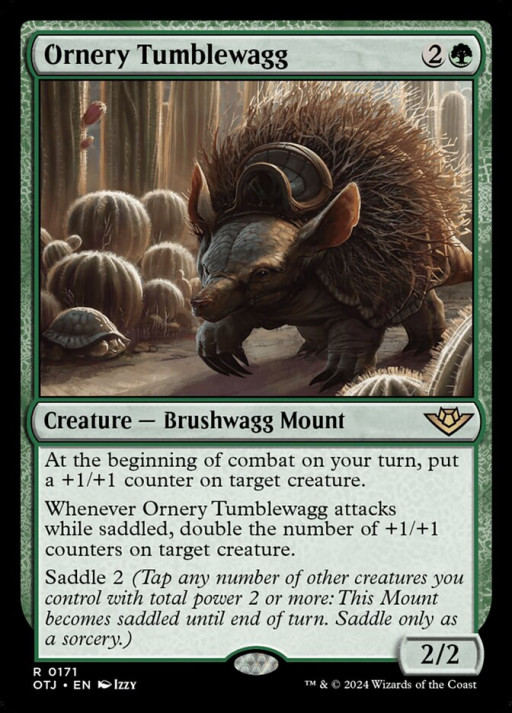
Saddle, one of the new mechanics in Outlaws of Thunder Junction, lets you tap your other creatures to activate a special effect a lot like Crew from Kaladesh. The difference is even if the creature loses its type it doesn’t lose its effect. Ornery Tumblewagg uses this ability to double +1/+1 counters on any other creature.
When you take into effect all the cards that require a +1/+1 counter to activate its ability, his passive effect really starts to open up possibilities. Cards like Kodama of the West Tree or Kami of the Whispered Hopes do things like giving modified creatures trample, or tapping for an enormous amount of mana based on the number of counters on it.
-
He is a little heavy at a three cost 2/2 but, his passive effect can buff himself each turn, as well as other creatures.
-
Passively boosts himself and other creatures every turn.
-
Has a relatively small saddle cost that you could activate with a token every turn.
-
Can be combined with a card like Kami of the Whispered Hopes or Ozolith the Shattered Spire, to double the +1/+1 counter each turn.
-
Potential to be a 6/6 by turn four if you add the counters to himself, 10/10 if you play Kami the next turn.
14 Up the Beanstalk (Enchantment)
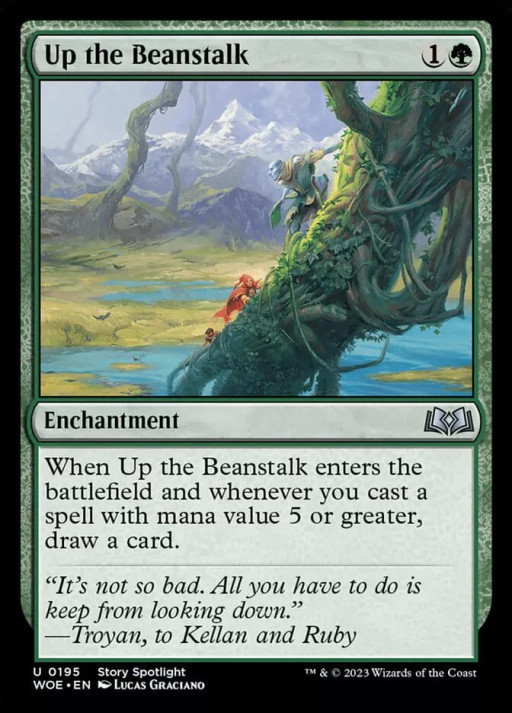
Up the Beanstalk honestly surprised me when I started researching it. At first glance it seems like OK value, netting you one card for two mana and subsequent draws for each spell costing five mana or greater. The great part about Magic the Gathering though, it's basically one big game of rules lawyering.
Delving into some of the forums on this card I quickly realized how divisive it seemed to be in the community. It turns out that just because a card says it costs five or more, doesn’t mean you have to pay that mana. There is a certain mechanic called Evoke that revolves around using your other creatures to cover the cost of some elementals.
Specifically two elementals called Solitude and Fury, that let you exile cards from your hand to pay the cost of these five mana creatures. It also triggers for cards like Leyline Binding or Lorein Revealed, letting you draw entire new hands in an instant. While currently legal in every format, there is quite an uproar to at least ban it in the popular format Pauper.
-
Two mana that draws upon entering the battlefield isn’t bad value to begin with.
-
Passive effect that will benefit you the entire game unless your opponent has a response.
-
Can be used in conjunction with mechanics like Convoke and Domain.
13. Railway Brawler (Creature)
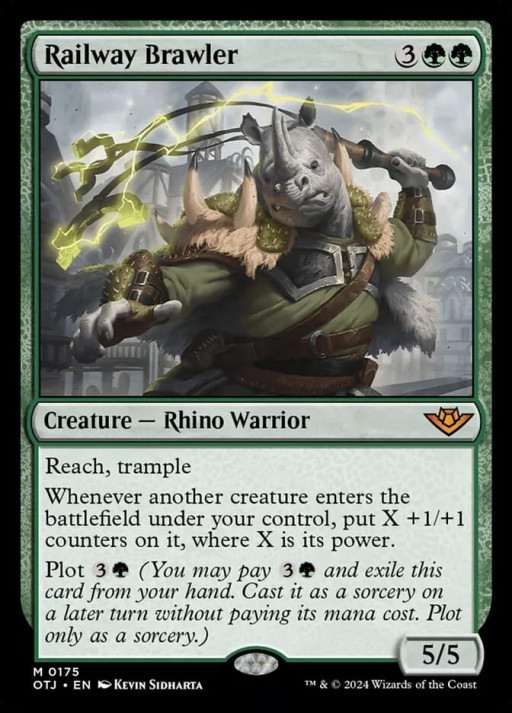
Reach and Trample, two major staples of any green creature. There are plenty of things in standard right now that would think twice about attacking once this creature is dropped. That hesitation will cost them though as any other creature you then summon will essentially have its power and toughness doubled.
Railway Brawler is a green player’s Christmas wish. I especially have a standard Kodama deck that is getting at least three of them. My creatures coming in with that many counters is exactly what I’ve been looking for to run over with Vorinclex.
He does have one advantage/disadvantage with his plot ability. While it does cost one mana less, you have to play it face up at a later turn of your choosing giving your opponent the opportunity to devise a solution.
-
Five cost 5/5 with reach, trample, and the ability to add counters to any new creatures.
-
Has a plot cost which lets you prepay for this card and summon it at a later time.
-
When used with a card like Kodama of the West Tree every creature becomes modified, gaining trample and a land every time they make combat damage.
-
Can be used with a Card like Kami of Whispered Hopes or Ozolith the Shattered Spire to double the number of counters placed each time.
12. Tranquil Frillback (Creature)
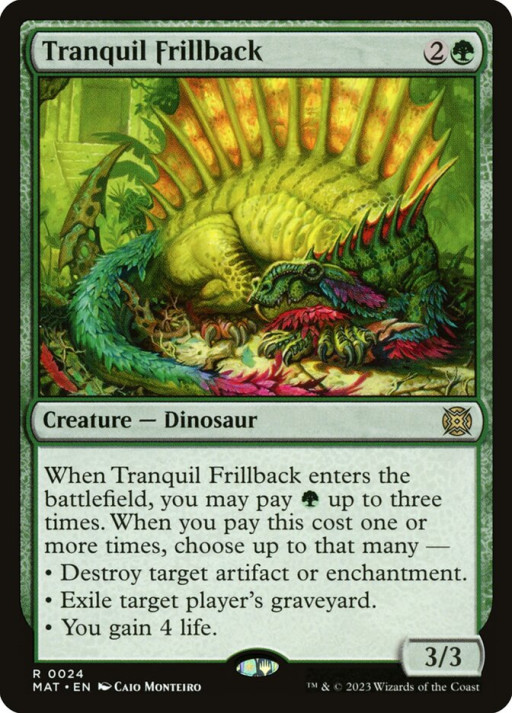
With this list being ranked in order of league popularity we are going to have some cards that aren’t game breaking or ban worthy, instead you sometimes get cards that everyone just runs out of necessity. Tranquil Frillback is one of those cards for the variety of bases it covers.
Need a creature, cast him for three. Need to remove that pesky enchantment or artifact that keeps causing you problems, cast him for four and blow it up while getting a 3/3 (and yes that does include artifact or enchantment creatures.) Pay six and sweep them all, while placing a board presence.
In this game there are a lot of best of one matches and you never know what you’re going to come up against. That’s where cards like the Frillback come in handy, letting you answer quite a few problems with just one card.
-
You can choose to cast just the creature in early game, or save him for a response.
-
Most enchantment or artifact destruction in standard costs two to three and doesn’t give you a creature.
-
Unfortunately you can’t pick the same option more than once but, you can pick up to three.
11. Spinewoods Armadillo (Creature)
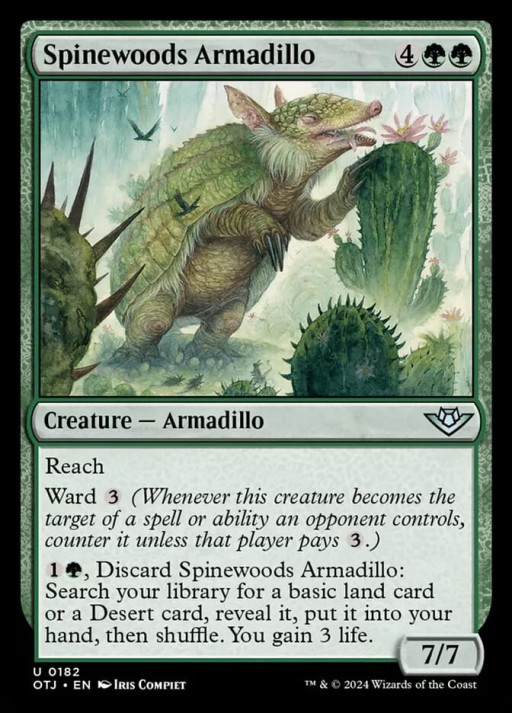
Spinewoods Armadillo is another card on this list that covers more than one base. Six cost, 7/7 with ward three is a beefy enough creature on its own. What makes him even more useful is his landcycling ability that lets you discard him for a basic land or specific desert. Gaining life isn’t really a major boon but, splashed in a white/green Selesnya deck and gaining life can activate other abilities.
Say you take a gamble on a two land hand while having this card, you could discard him to gain that third land. Maybe you need a Desert to activate a crime trigger every turn or, if all goes well, you could play him to put the pressure onto your opponent. There aren’t many damaging spells that will do seven damage, limiting the number of responses your opponent can make while paying an extra three mana.
-
Six cost 7/7 that charges your opponent to target it.
-
The discard ability can save you by discarding for a land and still getting value.
-
Has reach to block those pesky flyers.
-
Covers multiple bases and can respond to different situations depending on the need.
10. Outcast Trailblazer (Creature)
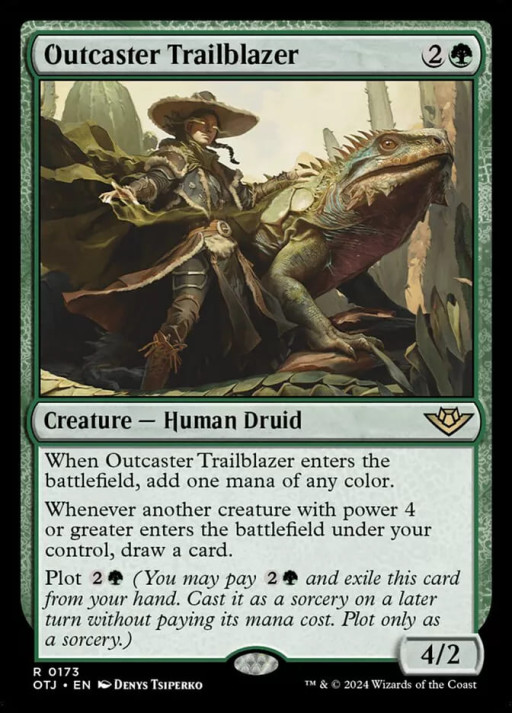
Outcast Trailblazer, the glass cannon of green from the latest set, Outlaws of Thunder Junction. While his toughness may be abysmal, the Plot mechanic lets you prepay his cost and play him whenever you like. This lets you plan for your opponents to tap out and play a bluffing game making them second guess every cast because they know what’s coming.
What makes Outcaster Trailblazer so good is when he comes in he gives you one of those mana back. You can also combo by playing him for free first, then playing a bigger creature or creatures, for his second ability. Even with his low toughness, you can choose to play smarter than your opponent and make him work in big ways.
-
A heavy power of four lets you use him as an attacker if push comes to shove.
-
The Plot cost is the same as the base cost giving you no disadvantage to use this ability.
-
The Plot mechanic can be saved for a rainy day when you don’t have anything else better to play.
-
Can be saved for a bigger creature to cheat a draw from his second ability.
-
Gives you one mana back when he enters, letting you play ahead of your opponent.
9. Freestrider Lookout (Creature)
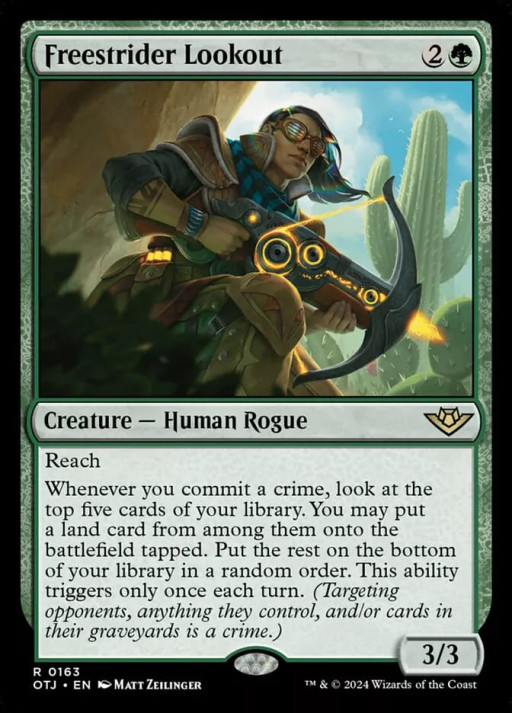
Bringing up the new Crime mechanic, Freestrider Lookout is one of the better triggers I’ve seen from the set. Three cost 3/3 with reach but, anytime you commit a crime you have the ability to ramp your mana by pulling lands from the top of your deck. When you think about how easy it is to trigger a Crime with one of those desert lands this card could reveal, you’ll probably be activating this ability every turn.
That alone is enough to boost Freestrider Lookout to the top ten of this list. Any card in Magic that lets you cheat out extra lands ahead of your opponent is going to see play. The really amazing part is the text in the ability defines a land, not a basic land.
The fact that it’s in green also means there are plenty of ways to put +1/+1 counters on Freestrider which will boost its defensive capabilities against flying creatures. Cards like Lotus Cobra or the new Bristly Bill have Landfall abilities that will trigger every time you reveal a land as well.
-
Three cost 3/3 with reach will help deter any would be attackers early on.
-
You can cast a desert with its ability letting you trigger Crimes every turn.
-
The text doesn’t specify that lands you reveal have to be basic lands.
-
Can be buffed with +1/+1 counters from other green sources.
8. Spelunking (Enchantment)
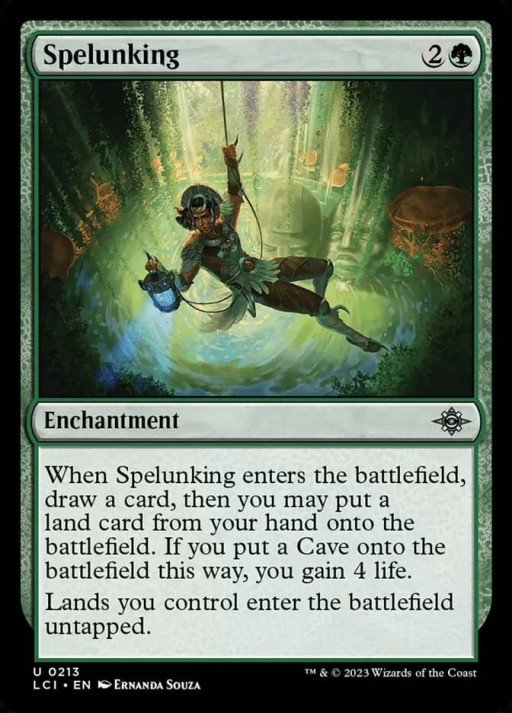
Another uncommon enchantment on this list, Spelunking is a major asset if you want to be able to ramp in standard. The fact that you get a draw and place a land from your hand on it entering already has players keeping this card in mind. If you decide to run a whole deck around caves and deserts then this card keeps giving returns.
The main focus of the enchantment though is the fact that lands come in untapped. This means that any dual lands that are required to come in tapped, don’t. This is huge for players running multicolored decks, as these taplands force you to play a turn behind. Of course there are extremely expensive rare versions that don’t come in tapped but, nine times out of ten you’re going to take damage every time you have to use it.
-
The immediate effects of this card mean it won’t hurt too bad when it’s destroyed.
-
This enchantment works with any taplands, including the triple lands.
-
This is a great enchantment to run in a caves or gates deck with cards like Sunken Citadel or Echoing Deeps.
-
(BONUS) Currently this card is bugged on MTG Arena, causing lands to come in tapped and then untapped as they enter, triggering effects.
7. Vaultborn Tyrant (Creature)
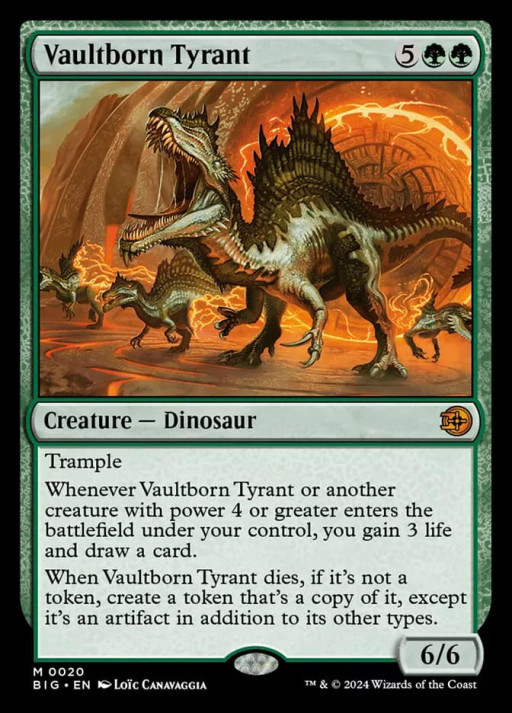
Even at first glance it’s easy to see why Vaultborn Tyrant is near the top of this list. Seven cost, trample, that gives you life gain and a draw every time another creature enters with power four or greater. His recursion will also force your opponent to burn their removal spells since that’s the only way to avoid making him “die”.
When you take into account cards like Flash that let you put a card from hand onto the battlefield without paying its cost if you sacrifice it, you start to imagine a whole lot more ways to cheat him out. I imagine this card will see a lot of play in commander formats or even a replacement for Ghalta in green decks due to the reliability of being able to cast him. The main feature of Vaultborn Tyrant though is the fact that you can swing him every turn without worrying about carrying damage over the top with trample.
-
A great creature for your heavy slot, dealing heavy damage every turn.
-
Can be buffed with counters or Vorinclex to create a truly unstoppable force.
-
Just playing him gets you a free draw and three life, helping to make some ground or establish your lead.
-
The only things that won’t cause him to recur are removal. If it gets taken out by damage you get a copy for free along with those ETB effects.
-
Comes back with an Artifact archetype, letting you combine it with effects like Mechanized Production or Phyrexian Metamorph.
6. Ancient Cornucopia (Artifact)
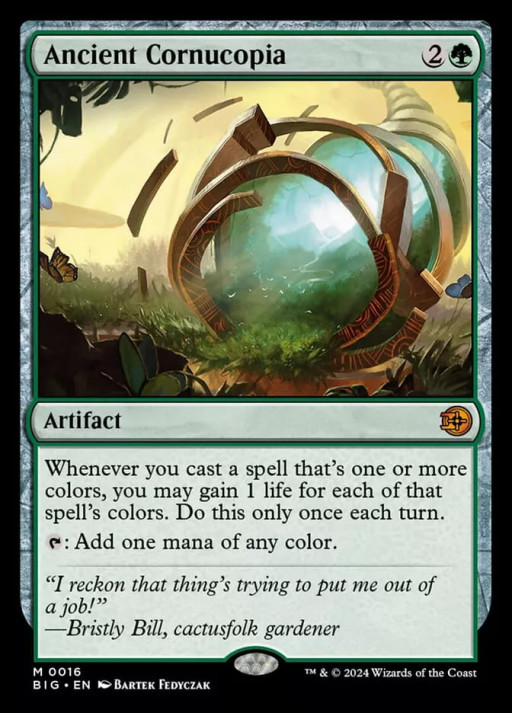
While Ancient Cornucopia is made more for multicolored decks, it is an extremely powerful utility that I expect to see a lot in Commander. A three cost artifact that lets you gain life (if you choose) the first time you cast a multicolor spell each turn. Some cards in Magic really require you to break down the wording and this is no exception.
The first big point is you may gain life, letting you choose whether or not to in case you’re up against something like Tainted Remedy. The second, and I think often misunderstood, is this only happens once each turn. That doesn’t say only on your turn letting you stabilize your health throughout the entire game. It also isn’t legendary so you can have four of these on the board at once, simultaneously gaining life and tapping for mana.
A lot of people are upset with this card because of the set it came out in, The Big Score. This set was stacked with a ton of powerful mythics and of which there were only two multicolored cards, making it essentially useless in drafts. As this breaks away into other formats there is a noticeable resurgence in multicolored decks since it only needs to sit on the battlefield to pay returns.
-
Three cost mana dork, that heals you for the first multicolor card you cast each turn.
-
Gives you the ability to refuse life gain if your opponent has weaponized it.
-
Non legendary means you can play up to four of these in constructed formats that stack.
-
Can be tutored or returned from the graveyard since it’s an artifact archetype.
5. Goldvein Hydra (Creature)

As a die hard green and Simic player I can’t tell you how excited I am to get another Hydra, I can hardly put into words how great this card is. Starting at the most unbelievable part, that single green mana. The fact that the only solid requirement to cast this card is a single green mana, you are free to play this card from turn two all the way to the bitter end.
Vigilance, trample, and haste, three of the strongest abilities in the game lets this Hydra attack immediately, stay untapped, and carry the damage over top. Add in cards like Ozilith or Kami of the Whispered Hopes and all counters are doubled cutting the cost in half and don’t even get me started on attacking with a Vorinclex.
Even if you’re forced to put this card out early, dying to damage nets you treasure tokens that let you ramp into even more powerful creatures. The fact that he doesn’t lose counters to damage or take multiple green mana with the X cost makes me wonder if this is the new best Hydra in the family.
-
Can be cast for as low as two mana to get out early.
-
If killed by damage you get mana equal to its power.
-
Doesn’t tap when it attacks, carries damage over smaller creatures, and can attack as soon as it comes out.
-
Can be used with cards like Ozilith or Kami of the Whispered Hopes, to double the counters placed on him.
4. Smuggler’s Surprise (Instant)
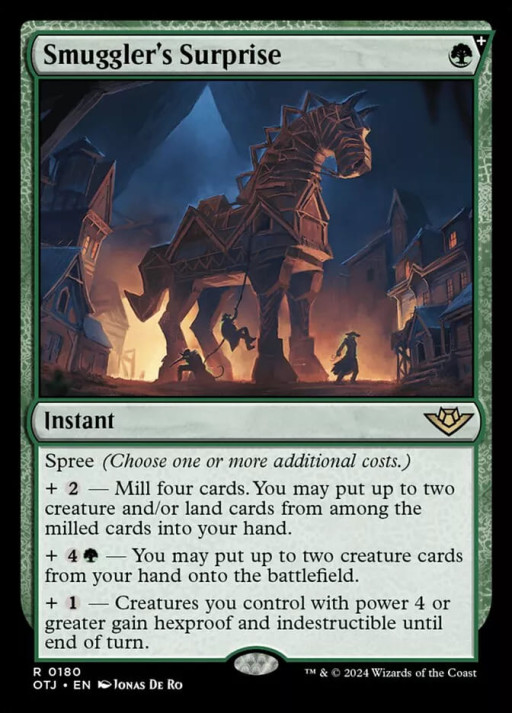
Smuggler’s Surprise, our first instant on the list all the way up in the top five. The new Spree mechanic opens a lot of options for responses or combinations with other cards. With this card, six mana could put two cards like Ghalta and Vorinclex on the battlefield without paying the thirteen mana cost, then dropping all other creatures in your hand for free with Ghalta’s ETB effect.
Running up against a heavy blue bounce deck, or a murderous black deck? Pay one extra mana to give all those creatures, with power four or greater, hexproof or indestructible and get them out without worry. Don’t have enough creatures in hand? Add another two mana for a grand total of nine, and pack your hand with ammunition.
It’s easy to see why this card is seeing so much play in league decks. With the heavy mana cost of creatures in Green, six mana for this second ability is surprisingly cheap. All the other mana ramp abilities will ensure you can get to the full cost earlier than your opponent expects.
-
The full cost of nine mana is much cheaper than a lot of creatures in Green, let alone two.
-
The instant speed means you can use this on your opponent’s turn, then have your full mana pool ready immediately.
-
The ability to give multiple creatures hexproof and indestructible for two mana is enough value on its own.
-
For three mana you can use this card by itself to stack your hand, then play another copy to get everything for cheaper.
-
Can be combined with cards like Isochron Sceptre, to copy Smuggler’s Surprise without paying its mana costs.
3. Aftermath Analyst (Creature)
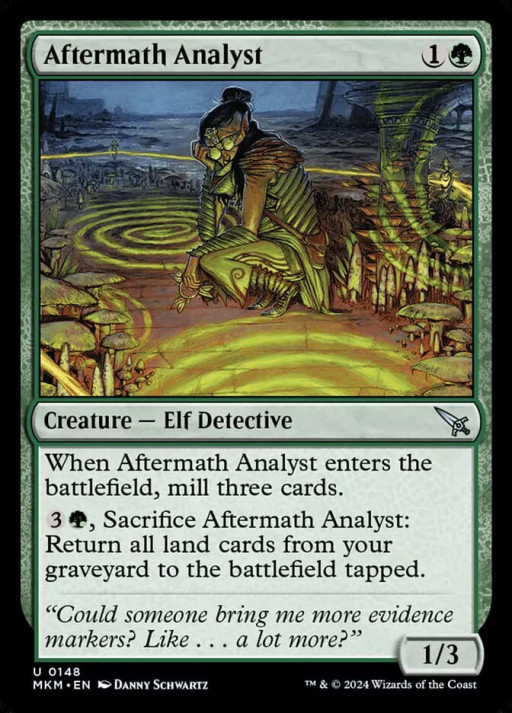
Aftermath Analyst is seeing play in a very specific sort of deck revolving around self mill. This may seem counterintuitive to newer players but, I assure you both green and black specialize in weaponizing your graveyard. I’ve dabbled in black/green Golgari myself and I can tell you from personal experience that having the ability to throw cards into your graveyard is a boon.
Cards like Fiend Artisan and Vengeful Pharaoh rely heavily on the amount of creatures or being in the graveyard themselves to work properly. Other cards such as the Gitrog Monster require you to sacrifice a land every turn or sacrifice itself, leading Aftermath Analyst to restock his food. What has people really excited about this uncommon though is the fact that the second ability doesn’t specify basic lands, letting you pull any and all specialty lands back to the battlefield.
Considering we haven't had a two cost creature with a mill trigger and land interaction since Skull Prophet from Ikoria, people are understandably looking for playsets of this card.
-
Two cost, self mill three, is a boon for standard Golgari decks.
-
The second ability will make sure to get back any lands that got caught up in the milling process.
-
Can be used to restock cards like the Gitrog Monster who requires you to sacrifice lands.
-
You can sacrifice him in response to a board wipe or targeting spell.
2. Bristly Bill, Spine Sower (Creature)

Bristly Bill, one of the new faces of Outlaws of Thunder Junction, has a lot of players excited in the white/green Selesnya family. There are so many different ways to Proliferate or double the amount of counters put onto your creatures, that having a Landfall ability give out counters is a huge boon in the community. The biggest problem you face with these types of decks though is finding a way to dole out those initial +1/+1 counters.
With Bristly Bill only costing two mana, you can start pumping out counters early on. From here it’s only a matter of time until your army is too big to handle. If you combine him with a card like Kodama of the West Tree and every creature that gains a counter becomes Modified, giving them Trample and pulling lands straight to the battlefield which then triggers Bill again.
It’s very easy to see why Bristly Bill ended up so high on this list with all the interactions possible with him. While he is legendary any green deck would benefit with a full playset, considering his initial toughness is so low. Don’t even get me started on him as a mono green commander in the EDH format.
-
Low cost means you can get him out and working early.
-
Can be used in conjunction with a plethora of other cards to grow exponentially.
-
His doubling effect is permanent, unlike creatures like Vorinclex that only last during combat.
-
There are plenty of ways to drop multiple lands a turn, triggering him multiple times.
1. Pick Your Poison (Sorcery)
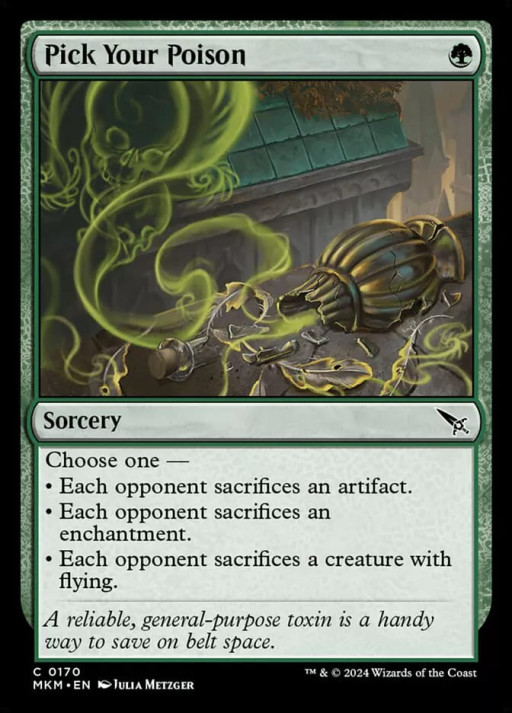
Finally to our number one spot, and somehow it's a common! I spoke earlier about how a lot of cards gain popularity because they become a staple in almost every league deck currently seeing play and, it’s easy to see why Pick Your Poison is so popular. It’s also so surprising that common would be this good.
One mana and force your opponent to sacrifice something of your choosing. This sorcery can only make them target one but, with its low cost, it’s extremely easy to force them into choosing what you want. There are so many low cost enchantment cards in standard right now that get played very early on and, if you don’t have a response they can ramp out of control in a matter of a few turns.
When you look at the third option things get a little more interesting. Say your opponent has played into a very strong win condition that has Flying and Ward, like Vein Ripper. Forcing them to sacrifice the creature themselves and circumventing the Ward cost altogether. You can run multiple of these in any green deck and be well defended from all angles and countless situations.
-
Pick Your Poison is a common so it will not be hard to find or source for all of your decks.
-
Circumvents abilities like Ward since your opponent must choose the target.
-
There are plenty of artifact creatures, giving you multiple paths to remove obstacles.
-
There are plenty of cards that let you copy the effects of cards, giving you the potential to use more than one effect.
Final Thoughts
Green is and always will be my favorite color in Magic the Gathering. With its focus on creature interaction and capabilities for growth, I’ve done as much as one hundred and eighty damage in a single turn. Granted this isn’t the norm and green does have its limitations, notably in creature removal but, it’s still an extremely fun and versatile form of magic.
If the thought of amassing an army of destructive elves and animals appeals to you, there are so many different styles of play once you begin mixing with the other colors. I for one am looking forward to all the latest cards from Outlaws of Thunder Junction that appear to be heavily focused around green.

